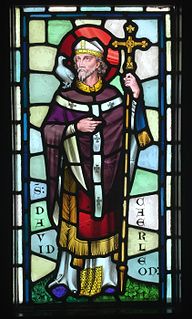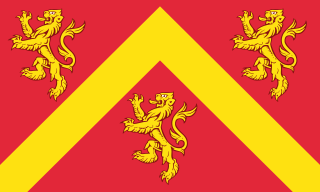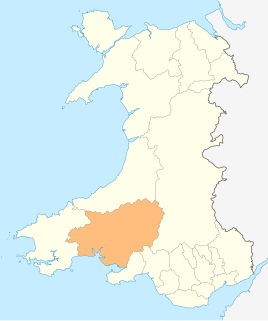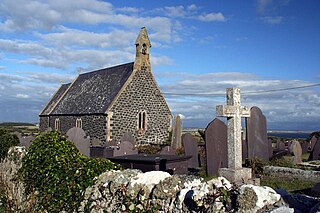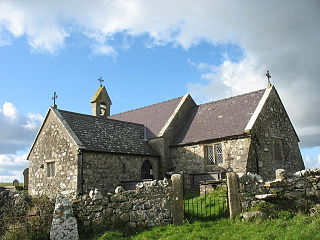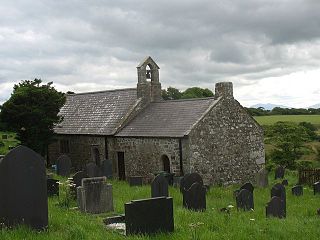
Seiriol was an early 6th-century saint, who created a cell at Penmon Priory on Anglesey, off the coast of north Wales. He later moved to Ynys Seiriol. He was a son of King Owain Danwyn of Rhos.

Bryngwran is a village and community in the Welsh county of Anglesey, located on the A5 London to Holyhead trunk road. It lies 8.1 miles (13.0 km) west of Llangefni, 7.0 miles (11.3 km) south west of Llannerch-y-medd and 7.4 miles (11.9 km) south east of Holyhead, and includes the villages of Bryngwran, Capel Gwyn and Engedi. At the 2001 census the community had a population of 781, increasing to 894 at the 2011 election.
Nidan was a Welsh priest and, according to some sources, a bishop, in the 6th and 7th centuries. He is now commemorated as a saint. He was the confessor for the monastery headed by St Seiriol at Penmon, and established a church at what is now known as Llanidan, which are both places on the Welsh island of Anglesey. He is the patron saint of two churches in Anglesey: St Nidan's Church, Llanidan, built in the 19th century, and its medieval predecessor, the Old Church of St Nidan, Llanidan. Midmar Old Kirk in Aberdeenshire, Scotland, is also dedicated to him: Nidan is said to have helped to establish Christianity in that area as a companion of St Kentigern. St Nidan's, Llanidan, has a reliquary dating from the 14th or 16th century, which is said to house his relics.

St Mary's Church, Tal-y-llyn is a medieval church near Aberffraw in Anglesey, north Wales. It was originally a chapel of ease for the parish church of St Peulan's, Llanbeulan, but the township that it once served, Tal-y-llyn, no longer exists. It was declared a redundant church in the early 1990s, and has been in the care of the Friends of Friendless Churches since 1999. Services are held once per month during part of the year.

St Iestyn's Church, Llaniestyn is a medieval church in Llaniestyn, Anglesey, in Wales. A church is said to have been founded here by St Iestyn in the 7th century, with the earliest parts of the present building dating from the 12th century. The church was extended in the 14th century, with further changes over the coming years. It contains a 12th-century font and a 14th-century memorial stone to Iestyn, from the same workshop as the stone to St Pabo at St Pabo's Church, Llanbabo.
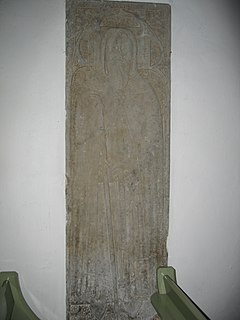
Iestyn was a Welsh hermit and confessor in the 6th or 7th century who is venerated as a saint. He was the founder of two churches, one in Gwynedd and another in Anglesey, both in north Wales.

St Eleth's Church, Amlwch is a parish church built in the Neo-classical style in 1800 in Amlwch, a town on the island of Anglesey in north Wales. It stands on the site of earlier buildings, with the first church here said to have been established by St Elaeth in the 6th century. Increasing prosperity in the town through copper mining during the 18th century led to the construction of a new church to serve the growing population.

St Tyfrydog's Church, Llandyfrydog is a small medieval church, in Llandyfrydog, Anglesey, north Wales. The date of establishment of a church on this site is unknown, but one 19th-century Anglesey historian says that it was about 450. The oldest parts of the present building are dated to about 1400, with the chancel dating from the late 15th or early 16th century. It is built from rough, small, squared stones, dressed with limestone. One of the windows on the south side is raised to illuminate the pulpit, a decision that in the eyes of one 19th-century commentator "disfigures the building."
Tyfrydog was a Christian from north-west Wales in the fifth or sixth century, who was later venerated as a saint. He is said to have established a church in Anglesey, and although no part of the original structure remains, the current church is still dedicated to him. A nearby standing stone is said to be the remains of a man who he punished for stealing a bible from the church.
Caffo was a sixth-century Christian in Anglesey, north Wales, who is venerated as a saint and martyr. The son of a king from northern Britain who took shelter in Anglesey, Caffo was a companion of St Cybi, and is mentioned as carrying a red-hot coal in his clothes to Cybi without his clothes getting burnt. After leaving Cybi, Caffo was killed by shepherds in the south of Anglesey, possibly acting in retaliation for insults Caffo's brother had paid to the local ruler. The area where he died has a village, Llangaffo, named after him, as well as the parish church of St Caffo, Llangaffo.

St Twrog's Church is a small rural church at Bodwrog in Anglesey, North Wales. Built in the late 15th century in a medieval style, some alterations have been made but much of the original structure still remains. It has two 15th-century doorways and some 15th-century windows. The bull's head decoration used on the church denotes a connection with the Bulkeleys of Beaumaris, a prominent north Wales family over several centuries. Set in a remote part of the countryside in the middle of Anglesey, it is dedicated to St Twrog, who was active in the late 5th and early 6th centuries. The church's tithes were paid for at least two hundred years to Jesus College, Oxford, which has historically strong links with Wales, and the college at one point built a house for the priest who served St Twrog's and a neighbouring parish.

St Caian's Church, Tregaian, also known as St Caean's Church, Tregaean, is a small medieval church dating from the 14th century in Anglesey, north Wales. It is dedicated to St Caian, a Christian from the 5th or 6th century about whom little is known. The building contains a late 14th-century east window and a late 15th-century doorway. The churchyard contains the grave of William ap Howel, who died in 1581 at the age of 105, leaving over forty children between the ages of 8 and 89 and over three hundred living descendants.

Gwenllwyfo was a female Christian recognised as a saint. She is commemorated in the dedication of two churches near Dulas, Anglesey, in Wales: St Gwenllwyfo's Church, Llanwenllwyfo and its medieval predecessor, the Old Church of St Gwenllwyfo, Llanwenllwyfo, which is now in ruins.
Cynfarwy was a Christian in the 7th century about whom little is known. He was venerated by the early church in Wales as a saint, although he was never formally canonised. St Cynfarwy's Church in Anglesey is dedicated to him, and his name is also preserved in the name of the settlement around the church, Llechgynfarwy. His feast day is in November, although the date varies between sources.

St Gwenfaen's Well is an early medieval holy well in the south west of Holy Island, Anglesey, named after St Gwenfaen, whose cloister was nearby. The site includes substantial remains of a building and is both a scheduled monument and a Grade II listed building. Traditionally, a gift of two white quartz pebbles thrown into the pool can cure mental health problems.
